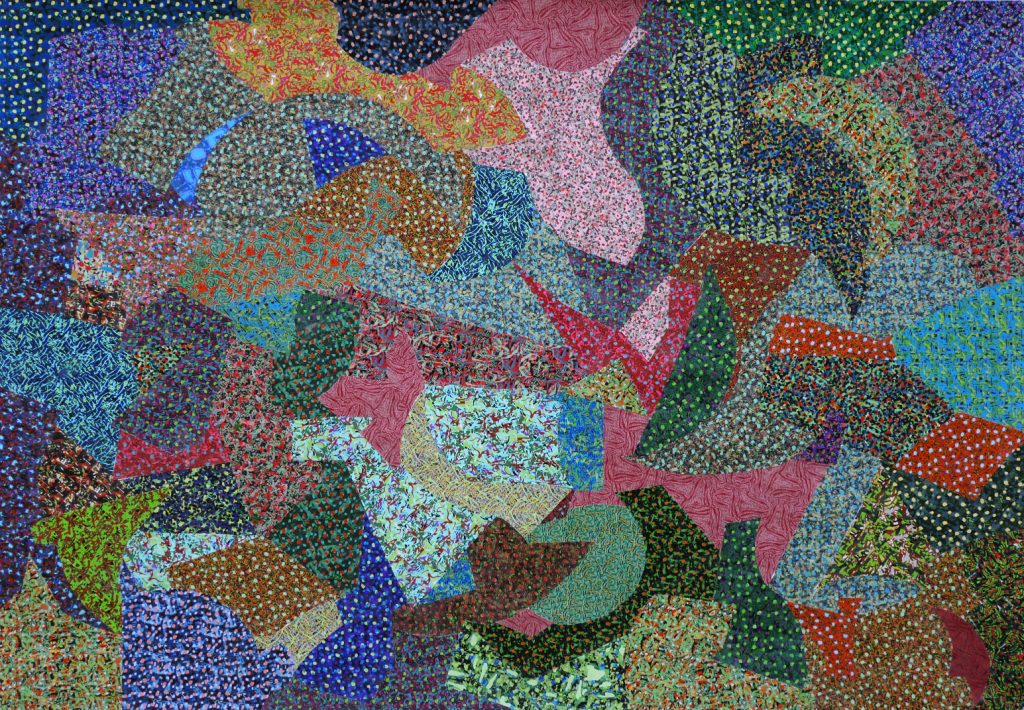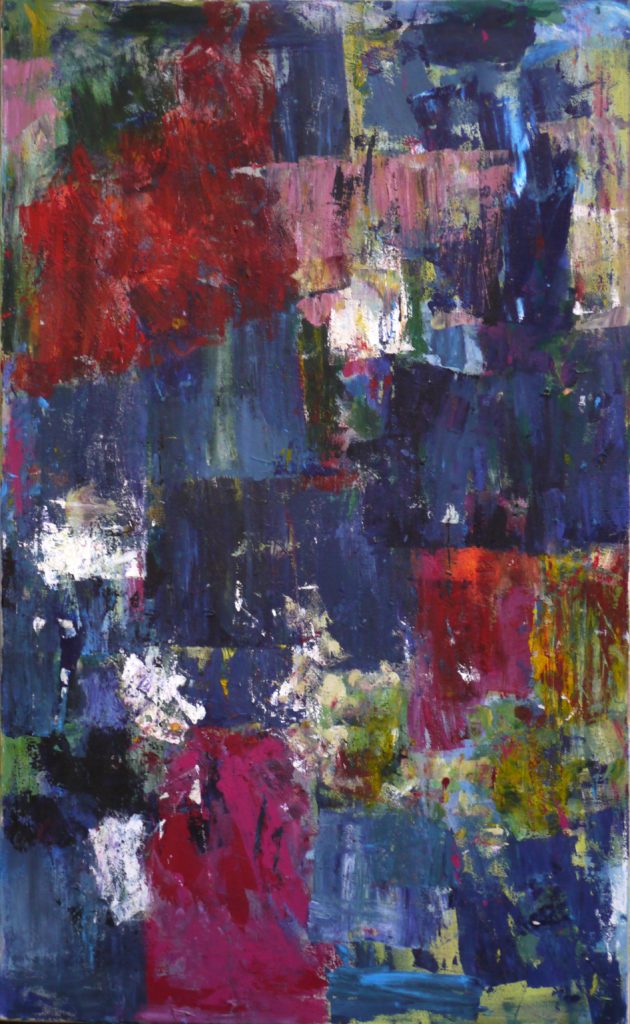A Feast for the Eye – an exhibition of paintings and collages by Jerry Scott
Clare Hall is delighted to present an exhibition by Jerry Scott, representative of the artist’s work over the last twenty years.

Frances Spalding, Art Committee Chair and Curator of this exhibition, writes:
Jerry Scott’s collages have rightly been called a journey through colour and texture, offering an experience of great richness and depth. Their characterful material presence owes much to the fact that he designs and prints his own papers, many of which are close-patterned and therefore add to the density of the overall effect. Damascene – Night Weaver is an example of just how immersive these collages can be: beautifully crisp in its arrangement of forms, it simultaneously shimmers with small dots of light. Many artists who use collage let in chinks of the ground beneath the collage, to point up the play between artifice and reality in the making of art. But Scott’s collages have a firmness and completeness that disavows teasing distractions. Instead, there is a strong sense of the physical involvement in the chopping, cutting, and abutting of one piece next to another. It comes as no surprise, therefore, to learn that Scott began his career as a sculptor, working with steel, and that, in whatever medium he has employed, there has always been a strong physical involvement with his materials.
His paintings have a quite different character. They are often rougher and more rugged, as in Crown Cardinal, in which a glorious suffusion of feeling comes through the unfussed blocks of warm and cool colours. His paintings, with their greater spontaneity and flexibility, seem to invite a more exploratory vein and a willingness to risk failure, which the brilliantly inventive and more polished collages do not permit. Both, however, depend on a sense of underlying formality: only very rarely does Scott include nowadays any hint of direct representation, yet his collages and paintings are often informed, directly or indirectly, by his love of gardens and nature. Scott is also a great looker at the art of others. On Instagram he has posted over 5,000 pictures over the last nine years, thereby attracting, with his discerning eye, a following for his finds. Some are little known works by major artists, but all are fresh and surprising, reawakening the pleasure given by a feast for the eye.
Clare Hall is delighted to show this exhibition. It conveys a passionate delight in colour, pattern and texture and the way they can be used to affirm the fullness of life. This is the kind of art that does not give itself up completely at first sight. Each time it is revisited, further, different, or new sensations emerge. Give time to Scott’s paintings and collages, and you will be surprised by these mutations.
Scott states in the catalogue:
First and foremost, the pictures must speak for themselves. Beyond this, I rely on a visual, sensuous engagement with the world. As a child I was fascinated and thrilled by such things as the velvety purple-blue of violets growing on a hedgerow bank, the buttery yellow and pale green of cowslips in a field, the purple and crimson cascade of a fuchsia, the magenta hues of sweet williams, the glossy brown of a freshly shelled horse-chestnut. I loved pictures too: there was a luscious flower painting which hung above the mantlepiece in my parents’ bedroom, and a portrait of my mother wearing a shimmering red dress. There were also the pictures in books from my father’s library – most memorably two large, heavily illustrated volumes on Matisse and Van Gogh. There were also the pictures in children’s books: the soft watercolours of Little Grey Rabbit stories, the vivid slabs of flat colour in Rupert Bear annuals, the garish gloss of the Eagle annuals. For Christmas and birthdays from the age of ten or eleven I was given illustrated books of artists who had caught my eye and I have them still: Cézanne, Gauguin, Matisse, Picasso.
The artist shares:
Delacroix wrote in his journal: ‘The first merit of a painting is to be a feast for the eye.’ It is a generous and unequivocal exhortation, and one with which I wholeheartedly agree. My paintings and collages, which form the two strands in this exhibition, aspire to be such a feast: a distillation of all the fulsome sensations and emotions which I experience in response to the colours and textures of the world around me.
These sensations and emotions, essentially abstract and beyond conscious thought or reason, are the wellspring of my work. At a purely practical level, both my collages and paintings are created by a process of accumulation. Often elements disappear beneath subsequent layers, having played their role in establishing the picture. Though invisible, they are critical elements in the process. The paintings are made with acrylics, the collages with papers which I have designed and printed. There are no deliberately representational images. I do not have any notion at the outset of what the finished picture will look like.
No preconceived ‘style’ shapes the pictures, though inevitably the experience of previous work plays its part. I try not to think my way forward during the making process. Instead, I watch out for a sequence of sensations and am on the alert for a certain deep reverberation (or ‘rhythm’ as Patrick Heron called it) when the picture takes on the hum of autonomous life. This is the time to stop. It is an ecstatic process full of joy, and impossible to articulate in words.

From an early age, I felt a powerful urge to respond actively, with pens, pencils and paints, to the onslaught of colour sensations and these efforts were nearly always abstract. I remember the urgency with which I set about it – an urgency which has remained to this day. I still have somewhere in the archive childhood colour scribblings made with the various implements available: delightfully waxy crayons, soft and hard coloured pencils, powdery and pleasant-smelling poster paints, crumbly pastels, little tins of hard block watercolours. Occasionally the urgency got the better of me and, with no scraps of paper to hand, I would scrawl in blank pages of books or on the wall next to my bed. I am scrawling still.
For me, the knife-edge of art is caught in a remark once made by the painter Roger Hilton: ‘All my thinking about art is haunted by a mystical belief that in its practice one is tapping sources of truth. If it were not that one caught, in this practice, glimpses of some certainties, one would not continue it …’
Useful information
- This exhibition was featured in Varsity‘s five must-see exhibitions article, October 2022.
- Accessibility details: full step-free access, accessible toilet, lift. For accessibility queries, please email our Porters.
- For media enquiries, please email Katherine Selby, Communications and Marketing Manager. Any other queries can be directed to Fiona Blake, Secretary of Clare Hall Art Committee.
- Discover more about art at Clare Hall via this page.